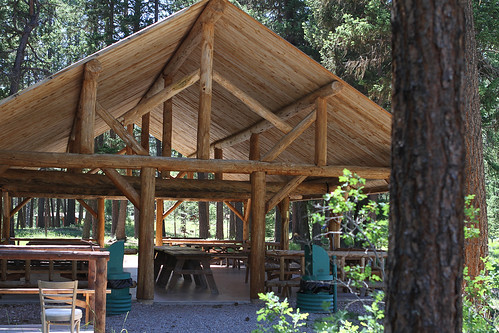
A pavilion on the Lubrecht Experimental Forest in Montana. (Photo Credit: Linda Nitz, Lubrecht Experimental Forest)
This blog was written by Emily Olsen from the National Forest Foundation.
Situated among ponderosa pine, Douglas fir, and other endemic tree species, Montana’s Lubrecht Experimental Forest lends itself to learning and adaptation. In March, the Experimental Forest was a seemingly perfect place to discuss restoration goals during the annual Southwestern Crown Collaborative Adaptive Management Workshop.
Here at the National Forest Foundation, we’re feeling refreshed after the workshop. Participants from the Forest Service, local communities, conservation, and academia came together to discuss what the Southwestern Crown Collaborative has learned from wildlife, aquatic, socioeconomic, and forest vegetation monitoring over the past year. But the discussions didn’t stop there. Participants also deliberated opportunities for monitoring information to inform and influence public lands management across the local landscape.
The approach of exploring, investigating and implementing new approaches based on monitoring outcomes is the hallmark of adaptive management. The Adaptive Management Workshop, a forum where participants could form connections between monitoring and restoration activities, may lead to implementation of new approaches in the future.
“The Southwestern Crown Adaptive Management Workshop illustrates why multi-party monitoring is a key component of the Collaborative Forest Landscape Restoration program,” said U.S. Forest Service Chief Tom Tidwell. “Collaborative project development, monitoring, and adaptive management are critical to inform and accelerate restoration work on the ground.”
The Southwestern Crown Collaborative is working on one of 23 Collaborative Forest Landscape Restoration (CFLR) projects around the country designed to sustain local landscapes and communities by leveraging resources, reducing wildfire risk, creating jobs and accomplishing restoration work. Following dangerous wildfires, declining timber markets, the spread of noxious weeds, and threats to the area’s famed wildlife habitat, the coalition of Southwestern Crown members came together from the Blackfoot, Clearwater and Swan River valleys to help determine the future of the place they call home. That place – dubbed the Southwestern Crown of the Continent – covers almost 1.5 million acres and is one of the most biologically diverse and intact landscapes in the West. The CFLR program recognized the landscape’s significance, and since 2010, CFLR funds have bolstered restoration, monitoring and collaboration.
In its fifth year, the 10-year CFLR program is at a turning point. The program has experienced success, as evidenced by the numerous accomplishments of the Southwestern Crown Collaborative and the other projects from California to Florida. A number of challenges to overcome have also been identified. For example, collaborative groups are finding that goals around multi-party monitoring and biomass utilization are often more difficult and time-consuming to reach than anticipated. Some groups are struggling to overcome member fatigue and capacity issues after working hard for more than five years to break gridlock and implement on-the-ground projects.
The Collaborative Forest Landscape Restoration Program Five Year Report, published in March, outlines many of these successes and challenges. The time is now to take a close look at the lessons gathered from the past five years and improve the program for the years ahead. As the report explains, “lessons learned through the projects can continue to inform and inspire landscape-level collaborative management efforts to accelerate restoration across the country.”
The National Forest Foundation has a long history of partnering with the Forest Service to share lessons, best practices and resources among agency staff, community partners and forest stakeholders. In forests from Alaska to Florida, we work with nonprofit partners, the Forest Service and citizens to reach consensus and build capacity for addressing the restoration and management needs on the National Forest System. We are committed to supporting and improving the CFLR program, and look forward to working the CFLR partners for the next five years and beyond.
No comments:
Post a Comment
Note: Only a member of this blog may post a comment.